Brand guidelines are central to upholding your brand identity.
Without them, your brand image is like a toddler moving away from paint by numbers—it’s going to get messy.
Add these detailed directions to your brand style guide and you’ll ensure consistency, combining the elements of your brand image like an expert artist.
You can use your brand guidelines across channels to ensure future projects never stray outside of the lines.
What do you include in these brand guidelines, how can you make a detailed style guide and what are some examples to inspire? Find out below.
We deliver custom branding solutions. Request a Quote
What Are Brand Guidelines?
Brand guidelines are the set of assets and instructions that communicate your brand’s identity and how it is displayed.
Located in a style guide, they detail all you need to consistently demonstrate what your company is, does and stands for.
Different to a brand kit, which collects the elements that make up your brand, brand guidelines are actionable directions that drive usage standards for websites, adverts or other branding collateral.
Meet our team. Schedule A Consultation
Benefits Of Brand Guidelines
Brand guidelines inform and instruct all your stakeholders, from employees to suppliers, on the core elements of your brand image.
This creates a range of benefits, including:
- Cross-channel consistency: You can reinforce your brand image across mobile and desktop devices, physical brand collateral and beyond with meticulous usage guidelines that drive consistency.
- Future project efficiency: New employees and project members can reduce delivery times and improve standards by reading your brand style guidelines to easily onboard to any branding project.
- Brand recognition and awareness: You can create a memorable eCommerce brand that drives recognition and awareness with on-brand messaging and visual elements across touchpoints.
Essential Elements Of Brand Style Guidelines
Brand style guidelines cover the core elements you need to reinforce your brand identity across channels. These include:
Element 1. Brand Strategy Overview
A brand strategy overview includes a combination of values, plans and targets central to your business.
Your brand strategy overview should include:
- A mission statement: A short description of your brand’s culture, goals and values
- Buyer personas: Examples and descriptions of your target audience
- Your brand story: A summary of your company’s history and purpose presented in a way that brings the story to life
Include a brand strategy overview in your brand guidelines to ensure your business doesn’t make decisions that deviate from its main goals, values or audience.
Element 2. Logo Guidelines
Your logo represents your brand identity through a memorable, distinctive design that tells your brand story.
Meanwhile, your logo guidelines describe how to use and showcase your logo to drive recognition, and therefore sales and conversions, across channels.
In fact, one in four adults is more likely to buy from a business whose logo is familiar to them.
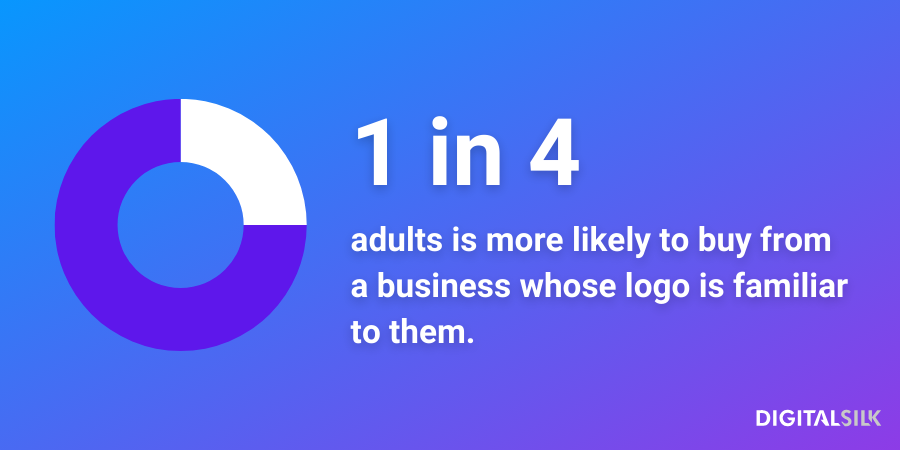
Your logo guidelines should include:
- Logo details: Explain the aspects, dimensions and design features of your logo.
- Logo mockups: Show your logo in multiple formats and across various brand collateral.
- Wrong logo usages: Provide examples of how not to use your logo.
Element 3. Color Palette Guidelines
Your brand should use consistent collections of colors across its branded materials to reinforce your visual identity and increase memorability.
So, adding color palette guidelines to your brand style guide drives uniformity for every piece of visual content or collateral you create, from your website to social media and printed materials.
This contributes to wider branding consistency, which can boost awareness and recognition of your brand and increase revenue by 33%.
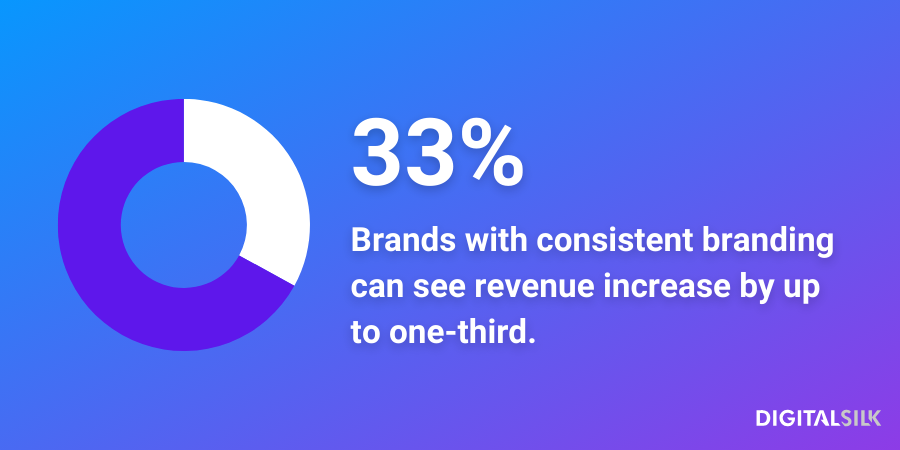
Your color palette guidelines should include:
- A primary color palette: Add the key colors that make your brand elements and assets distinctive to your central brand assets, like logo and website design.
- A secondary color palette: Add alternative, on-brand color schemes to help create dynamic and varied designs with supporting imagery that highlights the primary color palette.
- Color codes: Add HEX or RGB codes to easily implement your exact brand colors on future brand assets.
Element 4. Typography Guidelines
Typography is what makes written language legible, readable and appealing when displayed.
Your style of typography can also become synonymous with your brand when done correctly.
Your typography guidelines should include:
- Font specifications: Define a primary and secondary font to create uniformity across your branding and marketing efforts.
- Spacing guidelines: Outline the spacing between your fonts and around your typography to boost the impact of whitespace on your viewers.
- Visual hierarchy advice: Your branded campaigns, from websites to trade show booth designs, should create messaging hierarchies through sizing, positioning and highlighting.
- Accessibility considerations: Instruct how to make your typography accessible for all users, including those with visual impairments, with guidelines like contrast ratios and font size.
Element 5. Iconography & Imagery Guidelines
Your brand’s iconography and imagery are the symbols, illustrations and photographs you use to reinforce your brand identity.
These can range from background images to social icons and favicons.
Pre-define which icons and images will be used and how they need to be used to produce high-quality, captivating brand elements with every aspect accounted for.
Your iconography and imagery guidelines should include:
- Photography banks: List the types of images your brand can use (stock images or unique) and where to find them.
- Symbol designs: Insert your icon and symbol designs that can be placed across your brand collateral.
- Image specifications: Add sizing and optimization guidelines, such as the height, width and weight of your online images.
Element 6. Brand Voice Guidelines
Your brand voice guidelines define how you portray your unique personality throughout communication channels.
88% of consumers say authenticity is important when deciding which brands to support and do business with.
This makes maintaining a consistent brand voice that holds true to your values, mission and goals is an important factor in displaying authenticity to your target audience.
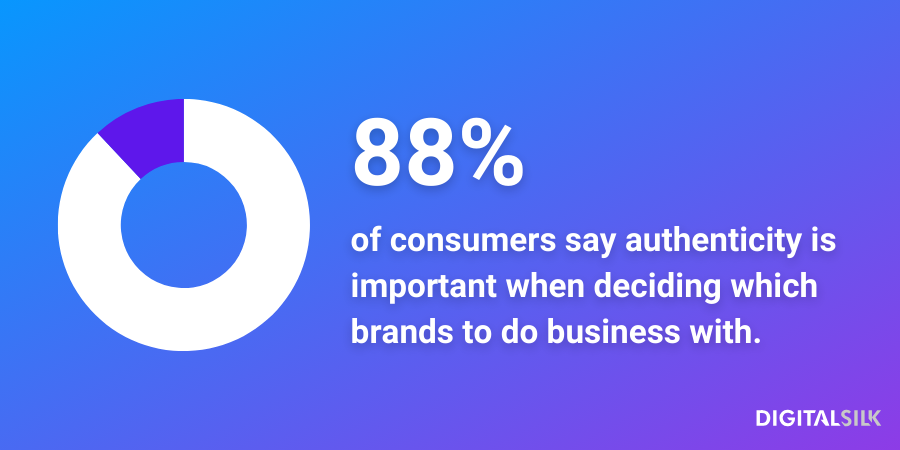
Your brand voice guidelines should include:
- Target audience notes: Track, update and define the personality of your target audience through Google Analytics, social media trends and in-person surveys to see which brand voice will resonate best.
- Brand values: Note your core brand values, mission and goals to weave into your voice and messaging.
- Vocabulary and grammar guidelines: List the specific terms and grammar instructions to use and avoid.
Element 7. Sample Collateral
Sample collateral are mockup examples of your brand elements used across various assets, digital and physical.
They help visualize how your brand design will look in real scenarios.
Your sample collateral should include:
- Logo samples: Place your logo across different brand assets, like your website favicon or a physical billboard, to show your logo guidelines in action.
- Color samples: Create multiple mock brand assets, like promotional products, that use your primary and secondary color palettes.
- Typography and messaging samples: Design a number of example campaigns that rely on your brand voice, messaging and typography templates.
We’re branding experts. Schedule A Consultation
7 Inspiring Style Guide & Brand Guidelines Examples
We create brand guidelines for businesses across industries. Explore seven of our recent projects to inspire your next style guide:
Example 1. Exactera
Exactera is an intelligent tax compliance software provider.
Our brand guidelines for Exactera ensure clear messaging, communication and sleek brand designs, enhancing the business’ presence across various touchpoints.
Specifically, our logo guidelines include sizing and iconographic instructions. This allows Exactera to adjust its logotype and logomark across channels, including app icons, website favicons and both digital and physical brand assets.
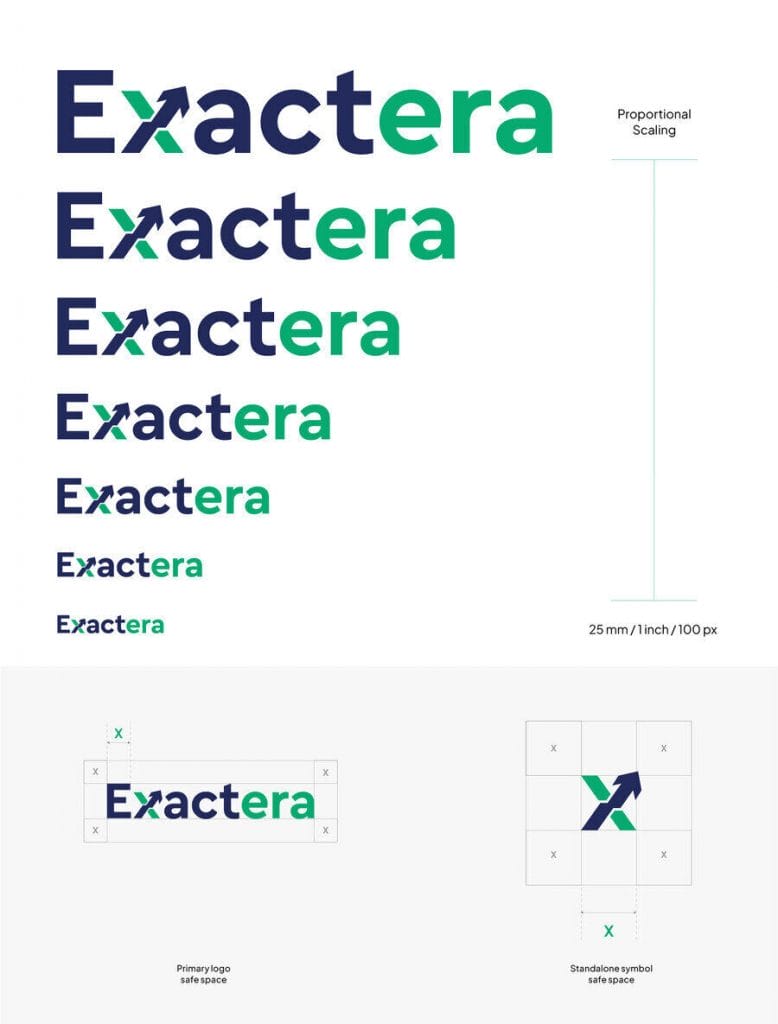
Example 2. NewDevRev
NewDevRev is a centralized platform for finding, promoting, buying and selling new development properties across New York City.
Our comprehensive brand guidelines included end-to-end logo concepts, color palettes and imagery all chosen by our branding experts.
We also added custom typography guidelines, with the sample page below showing how NewDevRev’s messaging takes hierarchy through visual elements like highlighting and bolding.

Example 3. Unison
Unison is an infrastructure asset acquisition and management company.
We provided extensive brand architecture solutions for Unison, following detailed guidelines to ensure a consistent brand image across locations, collateral and channels.
Included in our style guidelines were unique logo directions and use cases, including app icon and marketing collateral mockups.

Example 4. POWR2
POWR2 is an industrial energy storage company.
Our brand guidelines for POWR2 reinforce the business’ brand voice by providing thorough messaging instructions and hierarchies. This way, POWR2 can deliver consistent messages to build perceptions as a thought leader in the portable, hybrid electric power bank industry.
We also added custom illustrations that align with POWR2’s color palette to provide recognizable website and advertising imagery displayed at industry events.
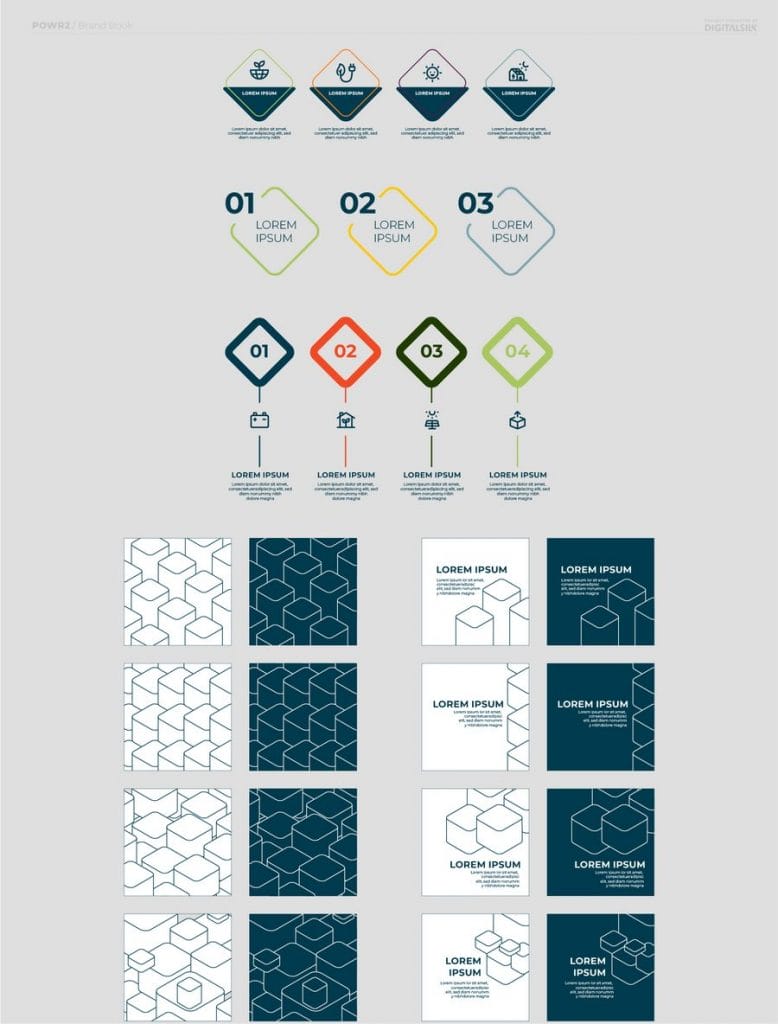
Example 5. Jeneil Biotechnology
Jeneil Biotechnology is a pioneer in fermentation technologies that manufactures and sells sustainable, scientifically produced products.
We delivered visual brand guidelines to help Jeneil tell a powerful visual story across a range of branded touchpoints.
Our style guide includes mockup collateral, such as brochures and trade show exhibit designs, to show how Jeneil can use its core brand elements over various campaigns and brand strategies.
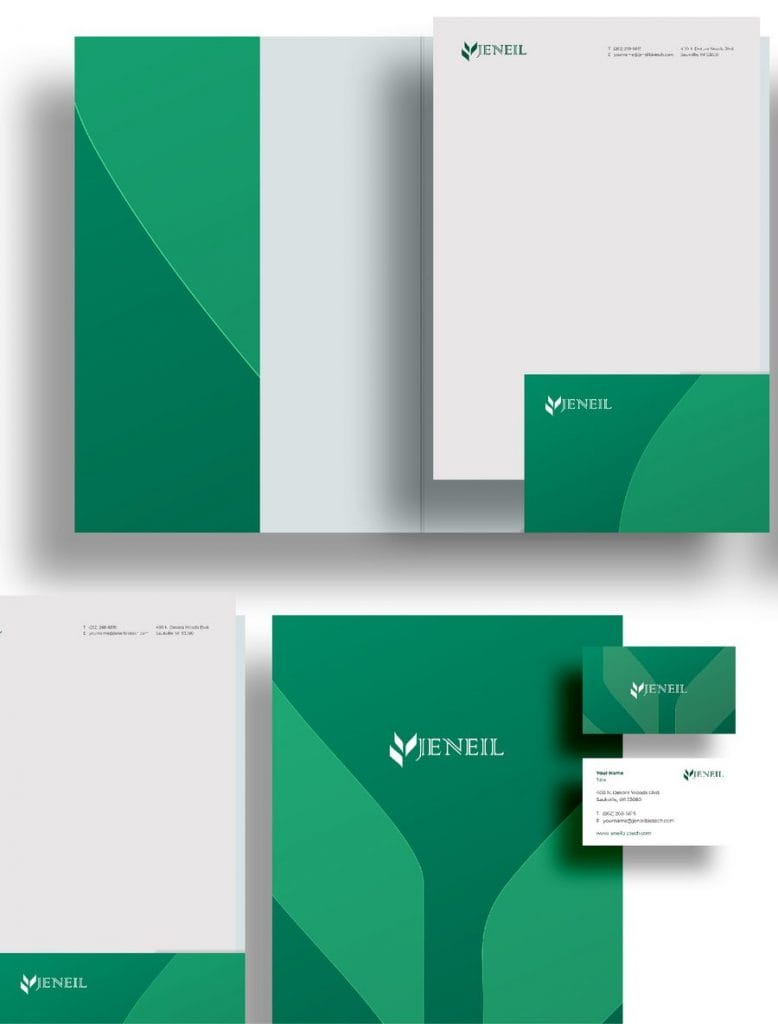
Example 6. Dognomics
Dognomics specializes in DNA test kits for dogs.
We placed our tailor-made logo design, color palette and typography guidelines in Dognomics’ brand style guide to support the creation of on-brand collateral, like its package designs.
By also including package design mockups with the company’s vibrant color palette, we helped Dognomics provide superior, distinctive product packages.
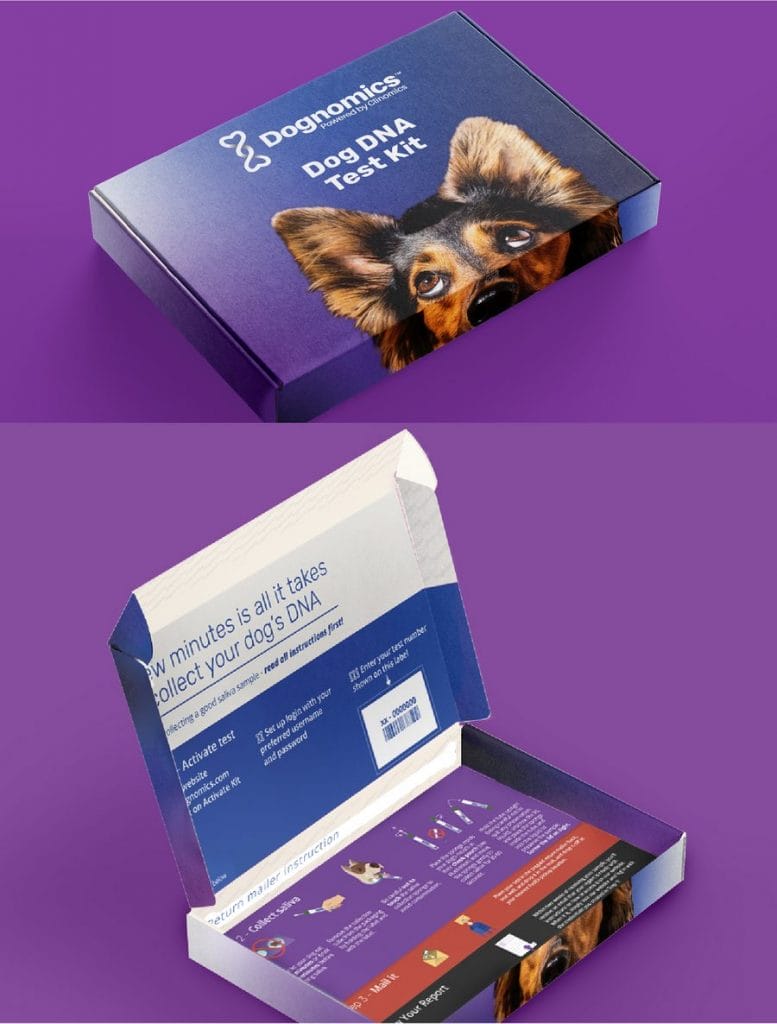
Example 7. EV Universe
EV Universe is an online marketplace for used and new electric vehicles.
Our custom brand guidelines helped EV Universe ensure brand consistency, resulting in greater online authority and digital growth.
The sample page below shows EV Universe’s primary color palette, with HEX codes and logomark usage guidelines to deliver high-quality, on-brand visuals throughout the website and potential branding assets.
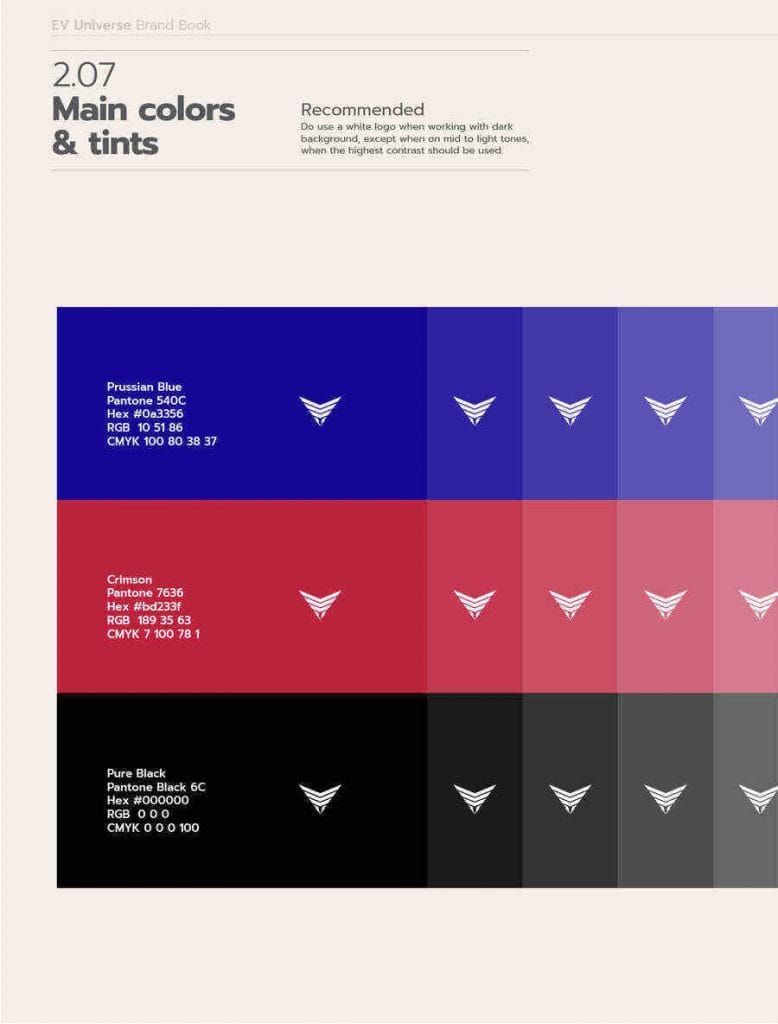
How To Build Your Brand Guidelines
When building your branding guidelines, it’s important to consider every aspect of your strategy that communicates your brand and its meaning to your target audience.
Beyond your logo, incorporate your colors, tone of voice and personality in your brand style guide to drive consistency across every element your brand presents.
Follow these five steps to build your comprehensive brand guidelines:
- Build a branded document: Lead by example and use your brand guidelines to create your brand book or style guide. This instils your core brand elements from the get-go.
- Add your visual and messaging elements: Showcase your core visual and print elements at the start of each section for employees, business partners or future designers to see.
- Provide usage guidelines: Add detailed usage guidelines within each section to guide future projects and deliver brand consistency for the future and across channels.
- Create easy-to-use templates: Streamline future projects with templates or design prototypes across various brand collateral and situations.
- Update regularly: Revisit your brand guidelines after any shift to your brand identity or visual strategy, as well as on a consistent basis to ensure everyone is refreshed on its key elements.
We deliver custom branding solutions. Request a Quote
Where Can You Use Brand Guidelines?
Using inconsistent brand elements can be a costly endeavor, which is why it is important to refer to the guidelines when devising marketing strategies.
Brand guidelines are essential for the following:
- Social media strategies: Maintain a cohesive brand presence across social media platforms by following guidelines for visuals, post designs and messaging tone.
- Print collateral: Apply brand guidelines to brochures, flyers and business cards to create visually consistent print materials.
- Advertising: Adhere to brand guidelines in online advertising campaigns, including banner ads, display ads and sponsored content.
- Content marketing: Apply brand guidelines to blog posts, maintaining a consistent visual style and use of brand elements.
- Brick-and-mortar locations: Implement brand guidelines in physical signage for retail locations and office spaces.
How to Create A Social Media Branding Strategy From Scratch
Having defined the elements and proper use of brand guidelines, it’s time to see how they fare in the dynamic landscape of social media.
Crafting a social media branding strategy is not just about consistency; it’s a strategic endeavor to connect with your audience on platforms that thrive on engagement and visual appeal.
Consider the following statistics:
- 50% of shoppers will check your social media before completing a purchase
- 78% of U.S. consumers discover new product on Facebook
- 92% of U.S. Instagram users follow a business account
Given the consumer habits prevalent across social media platforms, not having a strong and consistent presence on social media can result in loss of valuable revenue.
Follow the steps below to develop a social media marketing strategy that delivers measurable results.
Step 1. Choose Your Social Media Networks
Choosing the right social media networks is a crucial first step in developing an effective social media branding strategy.
Different platforms cater to distinct demographics and content preferences, and you want to create and target your ideal customer persona (ICP).
When defining your target audience, consider the following factors:
- Demographic data: age, gender, occupation, location
- Buying intent: the likelihood or probability that a consumer will purchase your product or service
- Personal goals: what your audience wishes to achieve, and how your product/service helps them do so
- Pain points: challenges or frustrations your audience faces and how your product/service helps them overcome them
When you have a specific buyer persona in mind, you can match that with the audience demographics prevalent on social media platforms.
For example, if your target audience are millennials or Gen-Z then Instagram would be the right platform for your business, given that these two age groups make up 88% of Instagram’s audience.
To guide you further on how to choose platforms for your social media marketing plan, here is a list of major social media platforms and their user demographics by Pew Research Center.
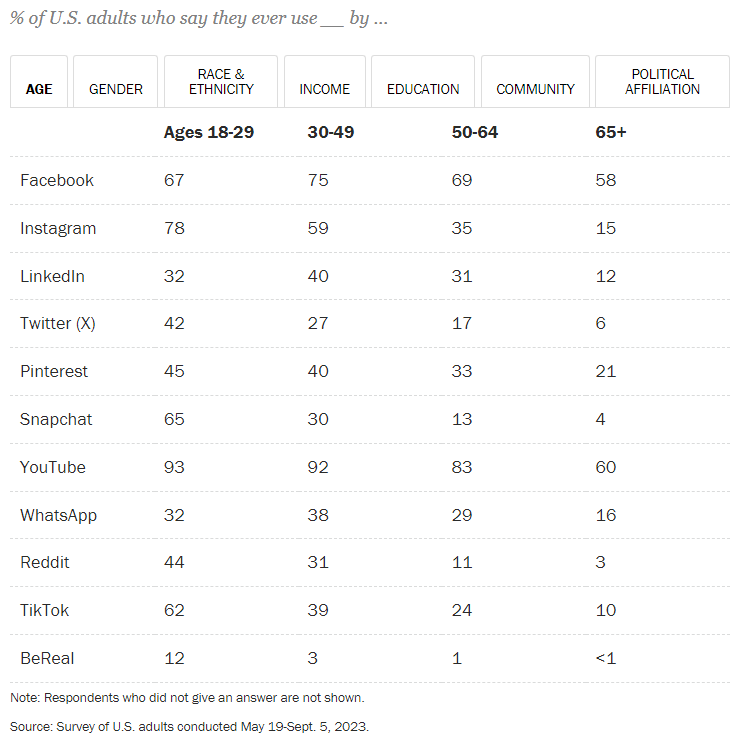
Step 2. Update Your Profiles With Consistent Messaging
After choosing social media platforms relevant to your business, updating your profiles with consistent messaging is the first step toward your social media branding.
Leave nothing to chance and fill up all the details required on each platform.
Consider your social media profile as your resume and update your details regularly. This includes:
- Your cover photo
- Profile picture
- Bio
- Awards and achievements
This will reflect professionalism and help potential customers see a clear overview of your business reputation.
Remember that your social media branding on each platform should be consistent, to show that it’s the same brand across all touchpoints.
For example, if you have a Facebook business page and an Instagram business account, your profile picture on both platforms should be the same. This way it’s easier for users to find you.
When it comes to your business bio, keep these tips in mind:
- Be concise: Many platforms have word or character limit — X, formerly Twitter, allows posts of up to 280 characters.
- Stay original: Original content can help users relate to you and perceive your brand as authentic.
- Speak to your target audience: Use language that your target audience uses: if you’re writing for restaurant owners write like a restaurant owner.
Step 3. Find Your Brand Voice
91% of marketers agree that brand voice is a core part of a business’ marketing strategy.
Keeping your business’ mission in mind, think of how your brand would sound if it was a human.
This means defining your brand with adjectives to determine how you should sound to your audience.
Here are a couple examples:
- Passionate
- Quirky
- Authentic
If your brand has any of these brand personality adjectives, you can start exploring your adjectives. Here is how you can do it:
- Passionate: expressive, enthusiastic, action-oriented
- Quirky: unexpected, different, irreverent
- Authentic: trustworthy, genuine, direct
Once you’ve established your tone voice, you want to consistently utilize it across marketing channels to engage your audience and boost your revenue.
Check out how @tacobell created their brand voice on social media.
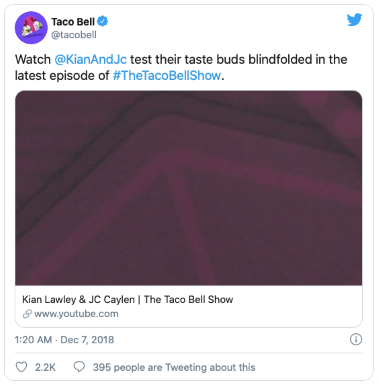
Step 4. Develop A Posting Strategy
Developing a content strategy will let you easily and consistently engage your audience for a set time.
It involves creating a plan for when and how you will post on your social media platforms.
When devising a social media posting strategy, it is important to keep the following factors in mind:
- Audience time zone: Post in times your audience is most active on social media.
- Platform peak hours: Determine when your audience is the most active.
- Day of the week: Engage your audience on days when they are most likely to be active on a specific social media platform. Weekdays are more efficient for B2B content, whereas weekends are more effective for consumer-focused content.
In a survey of 750 leaders in social media marketing, 90% stated that the success of their company depends on how effectively they can utilize social media insights to create business strategies.
This means that having a social media presence and an effective strategy is not just an addition to your business but a necessary component that can make or break your company.
To get the most out of social media, create a content calendar. This will help ensure the consistency and quality of your social media posting strategy.
Here are a few examples:
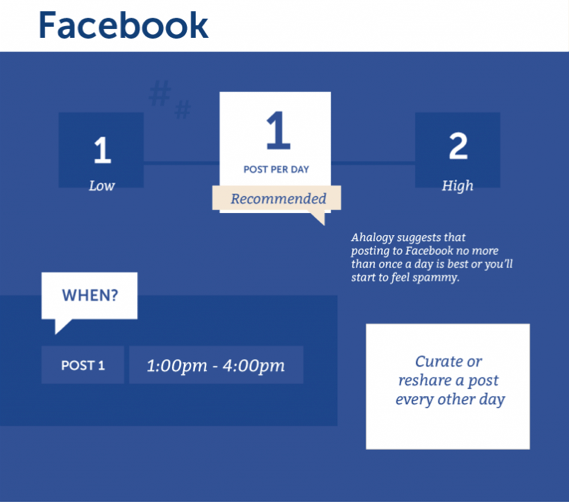
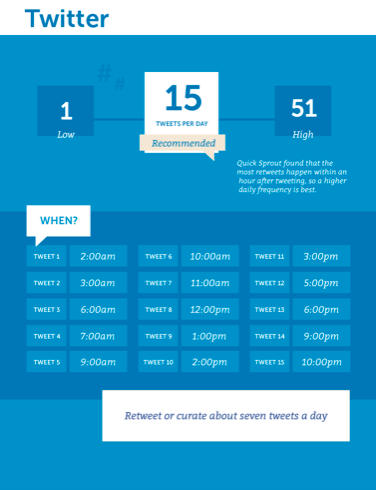
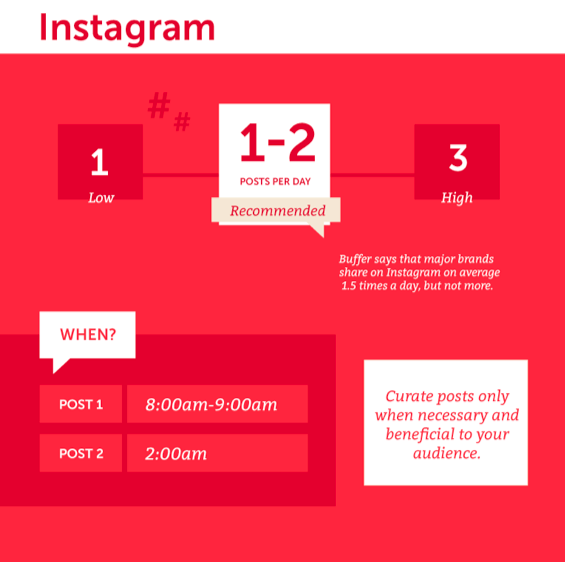
Step 5: Experiment And Analyze
As you start posting more on your social media platforms, you will begin to know what’s working for you and what isn’t.
You will also start realizing the best time and frequency of your social media posts. To keep a detailed track, you need social media analytics.
Most of the social media platforms have inbuilt analytics on their site. However, for a more comprehensive analytics experience, you can refer to many social media analytics tools available online.
Some of the best analytics tools include:
- Google Analytics: Provides valuable insights into website traffic driven by social media platforms
- Hootsuite: A comprehensive social media management tool that allows you to schedule posts, manage multiple social media accounts and track key performance metrics
- Buffer: A social media management tool that also provides analytics to measure engagement, post reach and other performance metrics across various platforms
Let’s discuss your project! Set Up A Consultation
Build Consistent Brand Presence With Digital Silk
At Digital Silk, we support every aspect of your company’s branding.
We create detailed instructions created by experts that cover your vital brand elements and help you reinforce your brand identity through consistency.
Our brand guidelines and brand book design solutions are part of our end-to-end solutions that grow your brand across channels. We also provide:
- Brand strategy
- Brand architecture
- Brand naming
- Brand design
- Logo design
- Brand marketing
- Brand package design
When we partner with you, we:
- Take project ownership
- Provide total transparency
- Drive measurable results
Contact us directly or call our team at (800) 206-9413 to request a free, custom brand audit and let us know about your unique brand guidelines requirements.
Or, simply fill out the Request a Quote form below!
"*" indicates required fields








